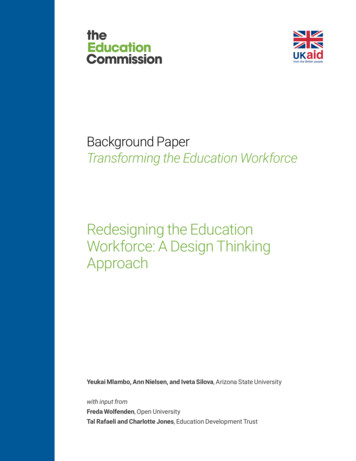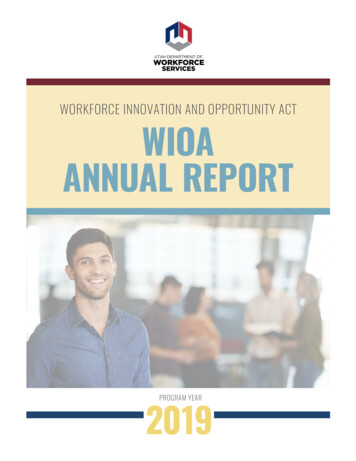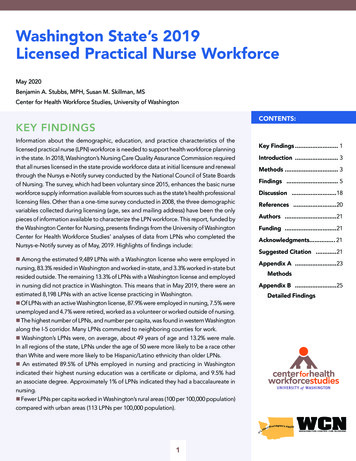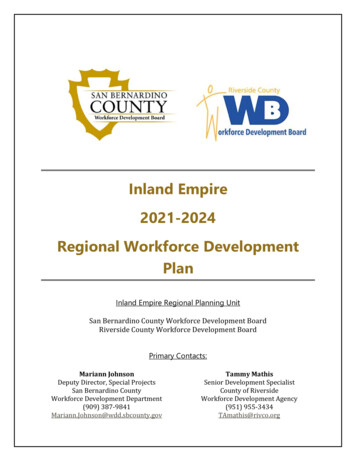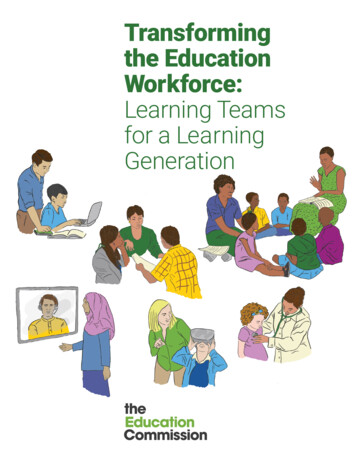
Transcription
Transformingthe EducationWorkforce:Learning Teamsfor a LearningGeneration
The Learning GenerationThe Education Commission is a global initiative dedicatedto greater progress on Sustainable Development Goal 4 –ensuring inclusive and quality education and promotinglifelong learning for all. The Commission is helping tocreate a pathway for reform and increased investmentin education by mobilizing strong evidence and analysiswhile engaging with world leaders, policymakers, andresearchers.Drawing upon new research and analysis from morethan 300 partners in 105 countries, the EducationCommission’s groundbreaking 2016 report – TheLearning Generation: Investing in education for a changingworld – put forward an action plan to deliver and financean expansion of educational opportunity for the morethan 260 million children and youth who are not inschool today. The Learning Generation report made 12key recommendations to improve performance, harnessinnovation, improve inclusion, and mobilize more andbetter finance.One of these recommendations was to strengthen anddiversify the workforce. Thanks to the generous supportof the United Kingdom’s Department for InternationalDevelopment, the Commission’s Education WorkforceInitiative has worked with several Commissioners andmany partners to produce Transforming the EducationWorkforce: Learning Teams for a Learning Generation –a report that offers visions for the urgent action neededto strengthen, diversify, and reimagine an educationworkforce to deliver quality education for all.Transforming theEducation Workforce:Learning Teams fora Learning Generation2
ForewordWe live in an age of unprecedented change and disruption. In some places,cars drive themselves, drones deliver packages, and refrigerators tell you whenit’s time to buy milk – but over 800 million children and youth around the worldare not on track to learn the skills needed to thrive now and in the future.With millions of precious young minds at stake, the harsh reality of the globallearning crisis stands in stark opposition to the “progress” promised by theFourth Industrial Revolution. We are running out of time to respond to oneof the world’s most fundamental needs: ensuring inclusive, equitable, qualityeducation for ALL our children.We are just over 10 years away from the 2030 deadline to meet this goal, asoutlined by the United Nations’ Sustainable Development Goal 4. How can weget there?Teachers are at the heart of the learning process and teacher quality is thesingle most important influence on learning outcomes at the school level. Butin many countries, teachers are in desperately short supply.And it is increasingly evident that teachers cannot work alone.As the African proverb says, “It takes a village to raise a child.” When thisethos of collaboration and care is applied to the learning process, we believe ittakes a team to educate a child. Teachers need leadership and support to beeffective at what they do best and to help reach those with the greatest needs.To build this support team, we must tap the potential of the broader educationworkforce – school and district leaders, specialists, learning assistants,community experts, entrepreneurs, health and welfare professionals, parents,volunteers, and many others – to create a responsive, evolving system thatkeeps pace with today’s changing world and equips young people with the newskills, knowledge, values, and competences they need to succeed.The Education Commission’s 2016 Learning Generation report called forthe strengthening and diversification of the education workforce, as well asthe establishment of an international expert group to take a fresh look atredesigning the workforce. Thanks to the support of the UK’s Department forInternational Development, the Commission’s Education Workforce Initiative(EWI) convened a high-level team of researchers, teachers, and policymakersthat spent more than a year digging out data, debating, and developing newapproaches to the challenges of workforce reform. This report is the result.(It takes a team to produce a report, too.)Transforming theEducation Workforce:Learning Teams fora Learning Generation3We are grateful to our country partners for their openness in collaborating withEWI to co-create and test concrete proposals for education workforce reformin Ghana; teacher deployment for equity in Sierra Leone; and adaptive hightouch, high-tech learning to support the STEM workforce in Vietnam.
Unsurprisingly, no “one-size-fits-all” model for education workforce designexists given the diverse social and political contexts of each country. Butgiven the workforce is an education system’s biggest investment, countriesshould make it a smart one. Robust learning systems are powerful leversof change, and members of the workforce should be strengthened andempowered to be change agents themselves.While more research and evidence is needed to evaluate the impact ofnewer approaches, we do know that many workforce models in use todayare outdated, inefficient, and unable to respond quickly enough to the rapidlychanging world around us.The unmet promise to the world’s children for universal quality educationdemands a transformative response. We believe the evidence, innovations,and vision of building collaborative learning teams for a learning generationshared here are a good start.The Education Workforce Initiative Leadership TeamJu-Ho Lee, ChairSusan Hopgood, Vice-chairTransforming theEducation Workforce:Learning Teams fora Learning Generation4Theo Sowa, Vice-chair
Tableof ContentsTransforming theEducation Workforce:Learning Teams fora Learning Generation58Executive Summary28Terms30Chapter 1Introduction34Chapter 2Reimagining the education workforce2.1 The broader education challenge2.2 The education workforce: the key to achieving SDG 4and future progress2.3 The education workforce challenge2.4 Global trends and opportunities to reimaginethe education workforce45Chapter 3Visions for the education workforce55Chapter 4Strengthening the education workforce4.1 Recruit the right people to the right places4.2 Prepare, train, and induct the workforce4.3 Motivate, professionally develop, and progress the workforce4.4 Lead and manage the workforce74Chapter 5Developing learning teams5.1 Optimize the right skills and expertise of the workforce at school level5.2 Reorient school leader roles to instructional leadership and inclusion5.3 Reorient the district to provide instructional leadershipand data-driven improvement5.4 Shift state-level focus to evidence-based strategic change incollaboration with the workforce5.5 Create structures and practices to support learning teams5.6 Key shifts in the education workforce at each level witha learning team approach94Chapter 6Transforming education systems into learning systems6.1 Develop innovative learning configurations to address individual learnerneeds6.2 Develop school networks and harness system leaders6.3 Leverage cross-sectoral partnerships6.4 Encourage a research and development culture where high impactinnovations are identified and scaled6.5 Key shifts in the education workforce at each levelin a learning system
Tableof Contents110Chapter 7How to make education workforce reform happen7.1 Navigating the political economy of workforce reforms7.2 Planning, costing, and financing the education workforce138Chapter 8Agenda for action8.1 Call to action for policymakers and the education workforce8.2 Call to action for international actors145AnnexesAnnex A: Design principlesAnnex B: Guiding questions for strengthening the education workforceAnnex C: Guiding questions for designing the workforce using learningteam and learning system ntsList of boxesTransforming theEducation Workforce:Learning Teams fora Learning Generation6323348525864Box 1:Box 2:Box 3:Box 4:Box 5:Box 6:73838485878993100103Box 7:Box 8:Box 9:Box 10:Box 11:Box 12:Box 13:Box 14:Box 15:105Box 16:107114123Box 17:Box 18:Box 19:135137Box 20:Box 21:Defining the education workforceDesigning and strengthening the education workforceBenefits of the learning team approachDefining networks for a learning systemChile’s approach to teacher professionalizationTransforming Teacher Education and Learning (T-TEL)in GhanaEWI in Sierra Leone: Teacher deployment for equitySchool level – illustrative teaching and learning rolesInstructional leadershipSchool level – illustrative leadership and management rolesDistrict level – illustrative rolesPeer learning enabling factorsEWI in Ghana: Redesigning the education workforceEWI in Vietnam: High-tech, high-touch learningSchool and district level – illustrative roles needed to workwith school networksSchool and district level – illustrative roles driven by crosssectoral partnershipsLearning from health: building an evidence-informed professionTeachers as a driving force in policy reformsHighly effective interventions to solve bottlenecksin the education workforceModeling teacher reallocation costsModeling costs for a route to teacher qualification
Tableof ContentsList of figures35Figure 1:38Figure 2:4047Figure 3:Figure 4:50Figure 5:53778292Figure 6:Figure 7:Figure 8:Figure 9:96108Figure 10:Figure 11:109Figure 12:126Figure 13:128Figure 14:130Figure 15:131Figure 16:Median learning-adjusted years of schooling by countryincome groupIn some countries, half of all graduates are neededto meet teacher demandTeachers’ time at primary school levelThree interacting visions for the education workforce to reachsystem goalsComparison between current class designand learning team designTransforming learning teams into a learning systemTheory of change for learning teamsA continuum of illustrative roles in learning teams at school levelKey shifts for a learning team approach by function at each levelin an education systemTheory of change for a learning systemKey shifts across functions at each level to transform into alearning systemA continuum of illustrative roles at school level ina learning systemHighly effective practices to increase accessand learning outcomesCost-effectiveness evidence from a professional developmentprogram and a community assistant programTeacher salaries as a percentage of total government expenditureon educationTeacher Community Assistant Initiative: Converting learningoutcomes data into an investment caseList of tablesTransforming theEducation Workforce:Learning Teams fora Learning Generation797130Table 1:Table 2:133Table 3:Examples of new learning configurationsHow can governments increase domestic financing for theireducation workforce?Illustrative areas where the international community can supportthe costing and financing of workforce reform
ExecutiveSummaryLearn more and download the full report:EducationWorkforce.org.Join the conversation online:#EducationWorkforce.8Note: All references for the ExecutiveSummary are included in the main report.
KeyMessagesThe challengeThe world is not on track to achieve Sustainable Development Goal 4 (SDG4). There are still more than 260 million children out of school and more than600 million in school who are not learning the basics or the skills, knowledge,and values required to thrive now and in the future.Teacher quality is the most important determinant of learning outcomes atthe school level, but in many countries teachers are in short supply, isolated,and not supported to provide effective teaching and learning.The opportunityTo meet SDG 4, teachers are critical but they cannot work alone. It takes ateam to educate a child – teachers need leadership and support to be effective and to help learners with the greatest needs.Achieving inclusive and quality education for all requires urgent action to harness the broader education workforce. The workforce is an education system’s biggest investment and one of its greatest levers for change.The education workforce must evolve to keep pace with the rapidly changingworld and embrace the new opportunities these changes bring.Three visions for changeWe can address urgent education challenges and leverage opportunities forchange by embracing three interacting visions.Vision 1: Strengthening existing systemsProfessionalize teachers and other key roles with appropriate recruitment,training, professional development, career paths, and working conditions toenable them to be effective.Improve workforce planning, deployment, and management, which meansrobust data must be available and utilized.Vision 2: Developing learning teamsDevelop collaborative teams focused on improving education outcomes inthe classroom, within schools, and at all levels in the system to result inmore effective teaching and better support for inclusion, on-the-job learning, and motivation.Developing learning teams does not necessarily involve hiring new staff – itentails diagnosing the challenges, understanding existing roles and skills, andconsidering how best to utilize them in a team; realigning roles; focusing anynew roles on the areas of greatest need; and enabling more teamwork.Vision 3: Transforming an education system into a learning systemHarness learning teams to build networks of schools, professionals, andcross-sectoral partnerships that use data and evidence to transform education systems into learning systems that are self-improving and adaptableto change.Executive SummaryTransforming theEducation Workforce9
Key MessagesHow to get thereWorkforce reform depends on context. Common ingredients for success include: strong leadership; drawing on evidence; engaging with and empowering the workforce to lead change; ongoing communication with key stakeholders; monitoring and adapting implementation; and building the structures to sustain reform.Financial support for investments in human and social capital of the workforceis needed. Smart investment will deliver longer-term returns through improvedefficiencies and greater effectiveness.Call to actionCollectively, we must take on the challenge of reforming the education workforce to test, analyze, scale and promote changes that better prepare and support the education workforce and young people to learn and work together sothey have the skills they need to succeed.We need to:1 Develop a workforce diagnostic tool underpinned by reliable data, indicators,and improved costing models to help countries dianose the challenges andimprove the design and management of their workforce.2 Experiment, research, and evaluate to explore what works and at what cost.3 Lead coalitions for change at all levels.Executive SummaryTransforming theEducation Workforce10
The role of the educationworkforce in achieving SDG 4The challengeWith only 10 years remaining until the deadline, the world is at serious risk ofnot achieving SDG 4. Today, there are still more than 260 million children outof school and more than 600 million in school who are not learning the basics,let alone the wider breadth of skills required to thrive in this century. TheEducation Commission estimates that despite some progress, by 2030 morethan 800 million children will still not be on track to achieve basic secondarylevel skills if current trends continue.Teacher quality is themost importantdeterminant of learningoutcomes at the schoollevel, but in manycountries teachers are inshort supply, isolated,poorly trained, and notsupported to provideeffective teaching andlearningTeacher quality is the most important determinant of learning outcomes atthe school level, but in many countries teachers are in short supply, isolated,poorly trained, and not supported to provide effective teaching and learning.To meet SDG 4, an estimated 69 million teachers must be recruited globallyby 2030, with over 76 percent of these in Sub-Saharan Africa and South Asia.In some of the poorest countries, the required increase in teachers is equalto at least half of the projected number of tertiary education graduates, givenlow secondary completion rates (less than 25 percent in Sub-Saharan Africa).Teacher shortages occur frequently in vulnerable communities and particularsubject areas, exacerbating inequality. On top of this, multiple interacting andoften systemwide factors can create conditions where teachers are absent ordo not spend enough time on instruction.In some low-income countries, even where there are teachers, many arepoorly trained or unqualified and often have limited pedagogical and subjectknowledge. In Sub-Saharan Africa, only 62 percent of teachers in primary schoolsand only 45 percent of teachers in secondary schools are trained to teach. Astudy of seven countries in Sub-Saharan Africa found that less than 10 percentof primary school language teachers could demonstrate a minimum level ofsubject knowledge skill to teach grade four students. Models of initial teachertraining and professional development are often outdated and ineffective. In theGambia, 77 percent of primary school teacher training instructors surveyed hadnever taught in a primary school themselves. Districts are often not providingeffective support. In Zimbabwe, teachers are on average visited every two and ahalf years by a supervisor and those in rural areas have to wait four years.Teachers often work in relative isolation and are expected to fulfillincreasingly diverse roles and to address a wider range of student learningneeds. The education workforce is not designed to deliver inclusive education,and inequities within the workforce itself are rarely recognized or addressed.For example in Sierra Leone, only 27 percent of teachers at primary level and14 percent at secondary level are female.Executive SummaryTransforming theEducation Workforce11
The opportunityTeachers are at the heartof the learning process,but this report emphasizesthat they cannot workalone. It takes a teamof professionals toeducate a child – teachersneed leadership andsupport to be effectiveand to help learners withthe greatest needsTeachers are at the heart of the learning process, but this report emphasizesthat they cannot work alone. It takes a team of professionals to educate achild – teachers need leadership and support to be effective and to helplearners with the greatest needs. Developing an effective teacher workforceby prioritizing the professionalization of teachers and ensuring their effectivemanagement is a critical first step to improve education outcomes. However,other roles and relationships, such as school leadership and managementroles, are also strongly associated with better education outcomes. Specialistand complementary education support roles have been effective in helpingreach those left behind and enabling inclusion. District roles have supportedteachers and school leaders to improve their practice and sustain changeand in a number of successful systems, state-level (central government)roles have used clear change leadership, coalitions, and evidence-basedadaptive policymaking to drive system change. Many of these roles alreadyexist in education systems, but they have received very little attention andthere has been limited experimentation on ways professionals with differentspecializations and levels of qualifications could work together effectively inlow-income country contexts.The education workforce must evolve to keep pace with the rapidly changingworld and embrace the new opportunities these changes bring. Expertspoint out that current education workforce design is still largely based on anoutdated model of education created to meet the labor needs of the IndustrialRevolution and organized on the principle of mass production. A moderneducation workforce must be able to respond to the world’s demographic shifts,environmental changes, technological innovation, advances in neuroscience,and evolving curricula. As the understanding of what teaching and learningcan look like is shifting, some of the best systems have started to adapt andinnovate in response. They offer examples of opportunities to think differentlyabout the education workforce.This report aims to catalyze new thinking on education workforce reform bydrawing on existing evidence and promising examples from education andother sectors, and using this to develop visions for the education workforceneeded in the future. The report uses a systems lens, considering the educationworkforce needed at the school, district, and state levels and throughout theworkforce life cycle, recognizing the interdependencies between workforceand other education policies, actors, the political economy, and financing.There is no “one-size-fits-all” model. Each system starts from a different point,faces different challenges and expectations, and operates in different socialand political contexts.Achieving equitable, quality education for all requires urgent action toharness the broader education workforce. The workforce is an educationsystem’s biggest investment and one of its greatest levers for change.Executive SummaryTransforming theEducation Workforce12
An education workforce fortoday, tomorrow, and the futureThis report outlines three interacting and iterative visions for an educationworkforce to deliver SDG 4: 1) incremental change to address immediatechallenges through strengthening the existing education workforce, 2) a shiftto a more collaborative education workforce through developing learningteams, and 3) a more radical paradigm-shifting vision through transformingeducation systems into learning systems.Three interacting visions for the education workforce to reach system goalsSource: Education Commission, 2019EducationWorkforceStrengtheningthe education workforceMore effective:Vision ng teamsTransforminginto a learning systemSkill optimizationLearners as individualsInstructional leadershipand inclusionSchool networksData-driven improvementCollaborativepolicymakingCross-sector partnershipsResearchand developmentTeamworkEducation system goalsAccessExecutive SummaryTransforming theEducation Workforce13LearningEquityInclusionVision 3Vision 2Management
Given that challenges vary between and within countries, these visions willneed to be adapted to specific contextual needs and are likely to involve hybridapproaches depending on the political economy and financing considerations.Vision 1: Strengtheningthe education workforceStrengthening the education workforce envisions an effective educationworkforce at all levels in the system, with coherent approaches to theprofessionalization of teachers and other key roles throughout theworkforce life cycle – from recruitment and preparation to professionaldevelopment and career progression to workforce leadership andmanagement.This vision aims to address the most pressing challenges and to get thefoundations right – by establishing decent working conditions and wages,and raising the status of teachers and other key workforce roles to attracthigh-quality applicants and address shortages. This will help strengthen theexisting “human capital” of the education system.Addressing teacher shortages is a top priority in many countries. Successfuleducation systems demonstrate that higher-skilled individuals can beattracted by raising the status of teachers, providing fair working conditions,and professionalizing them throughout the life cycle – recruitment, training,professional development, and career progression. Short-term “fast-track”solutions that decrease the entry criteria into teaching, often applied to respondto urgent needs, can have long-term negative consequences for professionalism.Recruitment should be merit-based and, where possible, based on clearly defineddispositions and capabilities. To address teacher shortages in underservedareas, systems should consider hiring more teachers directly from these areas;where necessary they should provide alternative school-based training routesthat address their needs. Incentives can be effective for addressing specificsubject or location shortages in the short term, but should be accompanied byother efforts to increase motivation and retention over the long term.Executive SummaryTransforming theEducation Workforce14The evidence from high-performing education systems shows that investmentin improving the standard of initial teacher training is critical to improvelearning outcomes. Although reform in this area can be challenging, it can bemore cost-effective to invest in high-quality teachers entering the workforcethan to rely on remedial in-service training. Teacher training institutions andtheir workforce should be supported to make reforms based on evidence ofwhat works. This includes putting a stronger emphasis on addressing trainees’foundational subject knowledge before building and applying greater subjectand pedagogical knowledge; including more school-based practicum; andaligning teacher training to what is relevant for the curriculum and context.Training courses should be inclusive in terms of trainee accessibility, coursecontent, and diversity of trainers. Structured induction programs should beintroduced for teachers and other roles when starting new jobs, and mentoringencouraged during the initial years.
Professional development opportunities should be made available to allteachers and other key roles and evaluated regularly. These should be practicebased cycles of quality improvement oriented towards improving teaching andlearning. Evidence suggests that professional development is most effectivewhen it is focused on a specific subject, is tailored to topics relevant to thelocal context, and provides supporting materials, coaching, follow-up visits,and collaboration opportunities to complement training. Low-tech approachescan facilitate professional development when combined with face-to-faceapproaches. When there is a large cadre of untrained or unqualified teachers,policymakers could consider a range of pedagogical support strategiesincluding structured pedagogy, frequent rounds of formative assessmentto support their development, and pathways to teacher qualifications oralternative education support roles (see Vision 2) if more appropriate. Careerprogression should be based on achievement of professional skills andcompetencies and result in salary increases.A learning teamapproach is aboutinvesting in the “socialcapital” as well as the“human capital”of the workforceWorkforce planning, deployment, and management need to be improved,which means robust data must be available and utilized. Deployment systemsshould use data to better match supply and demand, and consider workforcepreferences and equitable distribution of resources. This requires robust dataon the workforce, but a 2016 mapping found that only half of the countriessurveyed had any data available on teacher attrition rates or teacher trainingfrom the previous year. Data should also be used to target specialized supportto schools, prioritizing the most marginalized. Workforce management policiesmust address the root causes of workforce absenteeism. This includes settingsalaries at the same level as similarly qualified professionals and paying theworkforce on time and in an easily accessible way. In addition, requests forteachers to undertake activities that impact scheduled class time should beminimized and fair accountability mechanisms established.Vision 2: Developinglearning teamsThe current education workforce model in most education systems is builtaround a “one teacher to one classroom” model. Teachers work in relativeisolation, with limited support and often with challenging conditions such aslarge class sizes. To address this and other challenges, this report proposesthe development of learning teams aligned with evidence on what works toimprove education outcomes.Learning teams collaborate inside the classroom, within schools, withindistricts, and even at national and international levels. These teams ofprofessionals collectively focus on improving the learning and inclusionof all students and continually learn themselves.Executive SummaryTransforming theEducation Workforce15The learning team approach is based on a concept of professionalism thatleverages the collective capacity of a group of people as opposed to justfocusing on developing the skills of individuals to do their work better. It is aboutinvesting in the “social capital” as well as the “human capital” of the workforce.
A learning teamapproach at the classlevel ensures thatall the critical educationfunctions are sharedacross a team and notconcentratedon a single teacherA meta-analysis of factors influencing student achievement identified collectiveteacher efficacy as the single most powerful characteristic of highly effectiveschools and the leading factor influencing student achievement. A study in NewZealand found that teacher-peer collaboration doubled student achievements,but in a survey of 25 countries, only one-fifth of teachers reported participatingin mentoring or collaborative work. Team-based approaches are integral in othersectors such as early childhood development (ECD) and health, where they havedemonstrated improvements in service delivery, health outcomes, and costeffectiveness.Learning teams can include a variety of professionals – qualified teachers,trainee teachers, other teaching and learning roles, leadership andmanagement, and welfare professionals – within and across schools and atall levels in the system. A learning team approach at the class level ensuresthat all the critical education functions are shared across a team and notconcentrated on a single teacher. The diagram below illustrates the shift froma typical current class design to a learning team design, which reorganizes keyfunctions into teaching and learning, student welfare, instructional leadership,and operations and administration.Comparison between current class design and learning team designSource: Education Commission, 2019Currentclass designLearnersTeacherLearningteam desig
Transforming education systems into learning systems. 6.1 evelop innovative learning configurations to address individual learner D needs. 6.2 evelop school networks and harness system leaders D 6.3 verage cross-sectoral partnerships Le 6.4 courage a research and development culture where high impact En innovations are identified and scaled








